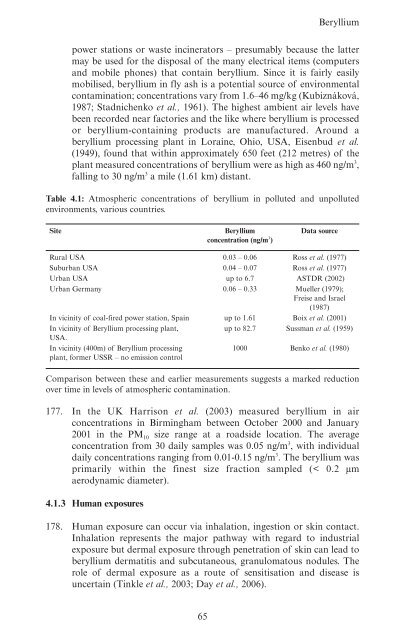Guidelines for Metals and Metalloids in Ambient ... - ARCHIVE: Defra
Guidelines for Metals and Metalloids in Ambient ... - ARCHIVE: Defra
Guidelines for Metals and Metalloids in Ambient ... - ARCHIVE: Defra
Create successful ePaper yourself
Turn your PDF publications into a flip-book with our unique Google optimized e-Paper software.
Beryllium<br />
power stations or waste <strong>in</strong>c<strong>in</strong>erators – presumably because the latter<br />
may be used <strong>for</strong> the disposal of the many electrical items (computers<br />
<strong>and</strong> mobile phones) that conta<strong>in</strong> beryllium. S<strong>in</strong>ce it is fairly easily<br />
mobilised, beryllium <strong>in</strong> fly ash is a potential source of environmental<br />
contam<strong>in</strong>ation; concentrations vary from 1.6–46 mg/kg (Kubiznáková,<br />
1987; Stadnichenko et al., 1961). The highest ambient air levels have<br />
been recorded near factories <strong>and</strong> the like where beryllium is processed<br />
or beryllium-conta<strong>in</strong><strong>in</strong>g products are manufactured. Around a<br />
beryllium process<strong>in</strong>g plant <strong>in</strong> Lora<strong>in</strong>e, Ohio, USA, Eisenbud et al.<br />
(1949), found that with<strong>in</strong> approximately 650 feet (212 metres) of the<br />
plant measured concentrations of beryllium were as high as 460 ng/m 3 ,<br />
fall<strong>in</strong>g to 30 ng/m 3 a mile (1.61 km) distant.<br />
Table 4.1: Atmospheric concentrations of beryllium <strong>in</strong> polluted <strong>and</strong> unpolluted<br />
environments, various countries.<br />
Site<br />
Rural USA<br />
Suburban USA<br />
Urban USA<br />
Urban Germany<br />
In vic<strong>in</strong>ity of coal-fired power station, Spa<strong>in</strong><br />
In vic<strong>in</strong>ity of Beryllium process<strong>in</strong>g plant,<br />
USA.<br />
In vic<strong>in</strong>ity (400m) of Beryllium process<strong>in</strong>g<br />
plant, <strong>for</strong>mer USSR – no emission control<br />
Beryllium<br />
concentration (ng/m 3 )<br />
0.03 – 0.06<br />
0.04 – 0.07<br />
up to 6.7<br />
0.06 – 0.33<br />
up to 1.61<br />
up to 82.7<br />
1000<br />
Data source<br />
Ross et al. (1977)<br />
Ross et al. (1977)<br />
ASTDR (2002)<br />
Mueller (1979);<br />
Freise <strong>and</strong> Israel<br />
(1987)<br />
Boix et al. (2001)<br />
Sussman et al. (1959)<br />
Benko et al. (1980)<br />
Comparison between these <strong>and</strong> earlier measurements suggests a marked reduction<br />
over time <strong>in</strong> levels of atmospheric contam<strong>in</strong>ation.<br />
177. In the UK Harrison et al. (2003) measured beryllium <strong>in</strong> air<br />
concentrations <strong>in</strong> Birm<strong>in</strong>gham between October 2000 <strong>and</strong> January<br />
2001 <strong>in</strong> the PM 10 size range at a roadside location. The average<br />
concentration from 30 daily samples was 0.05 ng/m 3 , with <strong>in</strong>dividual<br />
daily concentrations rang<strong>in</strong>g from 0.01-0.15 ng/m 3 . The beryllium was<br />
primarily with<strong>in</strong> the f<strong>in</strong>est size fraction sampled (< 0.2 µm<br />
aerodynamic diameter).<br />
4.1.3 Human exposures<br />
178. Human exposure can occur via <strong>in</strong>halation, <strong>in</strong>gestion or sk<strong>in</strong> contact.<br />
Inhalation represents the major pathway with regard to <strong>in</strong>dustrial<br />
exposure but dermal exposure through penetration of sk<strong>in</strong> can lead to<br />
beryllium dermatitis <strong>and</strong> subcutaneous, granulomatous nodules. The<br />
role of dermal exposure as a route of sensitisation <strong>and</strong> disease is<br />
uncerta<strong>in</strong> (T<strong>in</strong>kle et al., 2003; Day et al., 2006).<br />
65
















